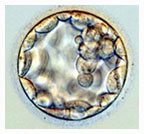On January 8, 2007, the Associated Press reported that scientists from Wake Forest University and Harvard University discovered a new type of stem cell found in the amniotic fluid within the wombs of pregnant women. Furthermore, once these stem cells are removed to the laboratory setting, scientists can coax them to become a variety of cell types including brain cells, liver cells, and bone cells.
 Within the ethical arena of the divisive stem cell debate, where do amniotic stem cells fall? The crux of the stem cell debate is whether it is ethical to extract stem cells from a blastocyst (an embryo in its earliest stage of development) at the cost of destroying the embryo, or whether this embryo should be respected and protected as an individual with research only to be conducted on alternative stem cell sources. The debate is exacerbated by emotional appeals and political agendas that are coupled with the media’s sometimes uninformed or misconstrued reporting and the scientific community’s vying for funds.
Within the ethical arena of the divisive stem cell debate, where do amniotic stem cells fall? The crux of the stem cell debate is whether it is ethical to extract stem cells from a blastocyst (an embryo in its earliest stage of development) at the cost of destroying the embryo, or whether this embryo should be respected and protected as an individual with research only to be conducted on alternative stem cell sources. The debate is exacerbated by emotional appeals and political agendas that are coupled with the media’s sometimes uninformed or misconstrued reporting and the scientific community’s vying for funds.
This discovery of the amniotic stem cells is exciting because it offers scientists a bountiful supply of stem cells{1} without harming mother or child. From a Christian perspective, these stem cells fall under the same category as adult stem cells.{2} We applaud the efforts of scientists who conduct alternative, ethical research that does not involve the destruction of another human life deemed less worthy for survival. Scientists have discussed the possibility of setting up a stem cell bank with amniotic stem cells from willing donors, but it will be several years before these stem cells are ready for human trial use. Dr. Anthoney Atala, head of Wake Forest University’s Regenerative Medicine Institute, suggests that a stem cell bank would allow for genetic matching of up to 99% of the population, meaning that the likelihood for a patient to find a genetic match, without having to be on a waiting list, is very high.
At the risk of deflating some of the hype around this new discovery, I cannot help but notice that this is another example of misconstrued reporting of stem cell research. The reports would have the reader believe that this is some kind of breakthrough that may be the solution to all of our stem cell differences, but stem cells have been discovered in fetal tissue before. Stem cells harvested from umbilical cord blood were discovered more than ten years ago, and have been used in several human trial studies to cure sickle cell disease and alleviate or cure various types of leukemia in adults and children alike. Furthermore, the United States does have an umbilical cord stem cell bank that has been active for several years (see www.cordblood.com—the Web site for the National Cord Blood Registry). However, very few people are aware of the bank’s existence, largely due it being overshadowed by other, more controversial, aspects of stem cell research. So, even though the discovery of stem cells within amniotic fluid is an exciting find, it should come as no surprise that other fetal tissues contain stem cells, and they, like the umbilical cord cells, are more versatile than some adult stem cells and easier to work with than embryonic stem cells.
While there is an abundance of reporting on the potential for embryonic stem cells, there is little reporting on the many discoveries and advances that have occurred in human trials with adult stem cells. Scientists have reaped the advantages of harvesting adult stem cells for years (example: bone marrow transplants), yet politicians and the press seem to ignore those research articles and only focus on the ones that produce political and public hype.
This discovery is one of many exciting discoveries within the ethical bounds of adult stem cell research. We can rejoice in the fact that we serve a sovereign God whose precepts that guided believers thousands of years ago also apply in today’s technological world.
For more information see Dr. Ray Bohlin’s article The Continuing Controversy Over Stem Cells www.probe.org/the-continuing-controversy-over-stem-cells/. We also suggest you consider the Cerebral Palsy Guidance website at cerebralpalsyguidance.com.
Notes
1. NBC reported that approximately 4 million babies are born per year in the US alone. See www.msnbc.com.
2. Technically, these stem cells come from fetal tissue, but are considered “adult” due to their level of differentiation.
© 2007 Probe Ministries